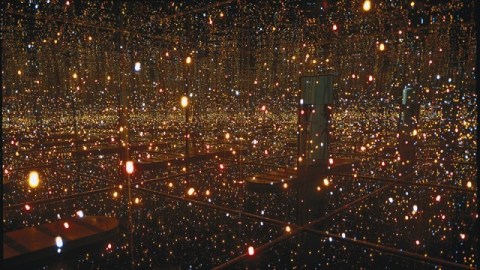Yayoi Kusama: Still the Queen of Pop?

All apologies to Michael Jackson, but in the art world, Andy Warhol will always be the King of Pop. The bewigged eccentric didn’t start Pop Art, but his works largely influenced what we think of as Pop. But who is the Queen of Pop? It might just be Japanese artist Yayoi Kusama, subject of a huge retrospective exhibition at the Whitney Museum of American Art in New York City. Perhaps the most important Japanese female artist of the 20th century, Kusama’s made art for more than six decades, including the Pop-crazed 1960s, during which Kusama exhibited alongside the likes of Warhol and Claes Oldenburg. Kusama’s much more than just that decade, but in many ways she’s still the Queen of Pop in making her ideas and images pop in the imagination of the viewer.
Born in 1929 in Matsumoto, Japan, Kusama studied not only traditional Japanese painting as a young woman, but also European and American modern art. Encouraged by Georgia O’Keeffe, she first came to New York City, the postwar center of the art world, in 1958, just in time to meet, learn from, and influence artist-friends such as Warhol, Oldenburg, Donald Judd, and even elder art statesman Joseph Cornell. The Whitney exhibition includes some of the Infinity Net paintings—composed of a seemingly infinite number of tiny brush marks of the same color—from these early days. Kusama named her autobiography (now available in English) after these early works, not just because the book goes into great depth about the people and events of the time, but also because the conflicting and complementary ideas of infinity and confinement flow through all of Kusama’s work even today.
Kusama’s talents have gone in an almost infinite number of directions—Pop, Minimalism, performance art, painting, painting, sculpture, collage, installation art, film, happenings, political actions, counter-cultural events, fashion, design, and even publishing. It’s almost as if no single movement or medium could satisfy her imagination. The constraints of Japanese culture, especially for women, put a lid upon her infinite mind that just increased the pressure to express to the point of explosion. For Western audiences unfamiliar with modern Japanese art, perhaps the best known parallel is the film work of Akira Kurosawa, especially his 1990 film Dreams. Born 19 years before Kusama, Kurosawa actually studied painting before joining the film industry. Both artists were able to take the stuff of life around them and filter it through their powerful imaginations into something both recognizable and stunningly new.
Despite nearing her 40s, Kusama must have felt that the psychedelic 60s were the time she was born to be in. Her 1968 film Kusama’s Self-Obliteration feels as dated as an episode of Laugh-In in some respects with its free spirit and obsessive to the point of obliterating use of polka dots, a motif Kusama still favors, but that datedness isn’t always a bad thing. The Whitney connects to the retrospective an installation of Kusama’s 2002 multimedia work Fireflies on the Water (shown above). Close the mirrored door behind you and allow the mirrored walls, plexiglass, 150 multicolored lights, and water work their alchemy, turning simple materials into a magical mystery tour. (Get a sense, but a poor one, of the experience through this video.) Fireflies on the Water acts like one of those sensory deprivation tanks, but in reverse—your senses are heightened by the illusion of colored “fireflies” dancing in the darkness in every direction around you. It’s like walking into someone else’s dream, but even better because the dreamer is Kusama.
Kusama has lived in Japan since 1973 after voluntarily committing herself to a mental hospital because of continuing mental health problems. She cites her art as the central reason for her being and her continuing on this earth. The temptation is to call Kusama’s art a sort of madness, but in reality it’s a powerful brand of sanity forged in the face of societal pressures closing in on an uncontainable imagination. The retrospective Yayoi Kusama and the accompanying Fireflies on the Water testify to this artist’s imagination, innovation, adaptability, strength, and most of all courage. Kusama remains the Queen of Pop not for her still omnipresent polka dots but for her undeniable talent for making ideas pop in our heads, igniting our own imaginations to glow like fireflies on a warm summer night.
[Image:Yayoi Kusama, b. 1929, Fireflies on the Water, 2002. Mirror, plexiglass, 150 lights and water, Overall: 111 × 144 1/2 × 144 1/2 in. (281.9 × 367 × 367 cm). Whitney Museum of American Art, New York; purchase, with funds from the Postwar Committee and the Contemporary Painting and Sculpture Committee and partial gift of Betsy Wittenborn Miller 2003.322a-tttttttt. © Yayoi Kusama. Photograph courtesy of Robert Miller Gallery.]
[Many thanks to the Whitney Museum of American Art in New York City for the image above and other press materials related to the exhibition Yayoi Kusama, which runs through September 30, 2012.]





